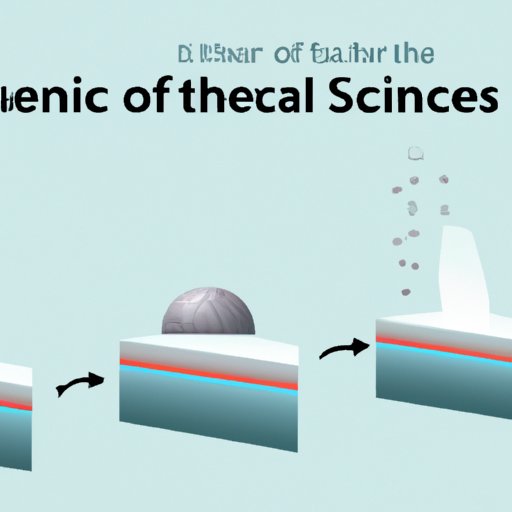
I. Introduction
The issue of melting ice has garnered much attention over the years. This is especially true in the context of global warming and its impact on the planet. However, there is a significant amount of confusion when it comes to understanding whether the process of melting ice represents a physical or a chemical change. The purpose of this article is to explore this idea and provide a better understanding of the science behind melting ice.
A. Overview of the Problem
As mentioned earlier, the issue of melting ice is a significant concern in today’s world. The melting of glaciers has increased rapidly over the past few decades, leading to rising sea levels and other environmental problems. Additionally, the process of melting ice can impact our daily lives, from causing accidents on roads to affecting our supply of fresh water.
B. Importance of Understanding the Nature of Melting Ice
Understanding the nature of melting ice is crucial for different reasons. First, it helps answer crucial questions such as why the ice is melting and its potential consequences. Secondly, it provides insight into the basic principles of physical changes and offers an opportunity to think about our science education differently. Lastly, it can help us address the problem better by giving us solutions that are science-based.
C. Brief Summary of Article’s Main Points
The article will explore the nature of melting ice, distinguish between physical and chemical changes, describe the process and science behind melting ice, and how the energy involved in the process plays a crucial role. We will compare melting ice with other physical changes and why understanding the properties of water and ice is crucial for solving problems related to melting ice. Additionally, we will examine the potential dangers of ignoring physical changes and how knowledge can lead to better decision-making.
II. Debunking the Myth: Why Melting Ice is a Physical Change and Not a Chemical One
A. Definition of Physical and Chemical Changes
To understand whether melting ice represents a physical change or a chemical one, it is essential to define both concepts. Physical changes happen when a substance changes its appearance, but its chemical composition remains the same; on the other hand, in chemical changes, the chemical composition changes.
B. Explanation of Why Melting Ice is a Physical Change
Melting ice represents a physical change because it changes the physical state of the ice while retaining its chemical composition, which is H2O. Specifically, the temperature changes, and the ice converts to water, while the water molecules don’t change.
C. Common Misconceptions Surrounding Melting Ice
There are many misconceptions surrounding the idea of melting ice. For example, some people argue that the process represents a chemical change since the ice converts into water. However, this argument isn’t accurate because the chemical composition doesn’t change, and water and ice are forms of the same molecule, representing the same composition.

III. The Science Behind Melting Ice: Understanding Physical Changes
A. Overview of the Physical Properties of Matter
Before discussing the science of melting ice, it is crucial to understand the physical properties of matter. Matter is anything that takes up space and has weight. Additionally, it has different states, such as solid, liquid, and gas, which are determined by its temperature and pressure.
B. Explanation of Intermolecular Forces and How They Relate to Melting Ice
One of the critical factors in melting ice is the intermolecular forces holding water molecules together. These forces are relatively weak, and heat increases the kinetic energy of the molecules, breaking these bonds, and changing the physical state of matter.
C. The Role of Energy in Physical Changes
The role of energy is also an essential factor in physical changes. The energy transferred to the substance causes a change in the stacking patterns of molecules leading to phase change to liquid in the case of melting ice.
IV. How Melting Ice Reveals the Basic Principles of Physical Changes
A. Explanation of the Process of Melting Ice as a Physical Change
The process of melting ice happens through an increase in temperature, which leads to the transfer of energy from the surroundings to the ice. This energy breaks the bonding between the molecules. As the energy continues to increase, the ice turns into liquid water, but its composition remains the same.
B. Comparison Between the Melting of Ice and Other Physical Changes in Matter
Physical changes happen in many states of matter other than ice. For example, melting chocolate involves changing the state of the chocolate substance from solid to liquid through heat. Similarly, when a gas changes to a liquid through cooling, this is also a physical change.
C. Examples of Other Physical Changes in Daily Life
Physical changes happen all around us. Examples include melting ice, dissolving salt in water, changing the shape of clay, and evaporation. Understanding physical changes and these examples can help us develop a better appreciation for the world around us and how it works.
V. From Solid to Liquid: Analyzing the Process of Melting Ice as a Physical Change
A. Step-by-Step Breakdown of the Process of Melting Ice
The process of melting ice happens in the following steps:
- The ice starts to absorb heat, which increases the temperature and its internal energy
- The kinetic energy of the water molecules increases, and bonds between them break
- The temperature remains constant at 0 degrees Celsius as energy is used up in absorbing a perfect amount of heat, which breaks the bonds between the ice molecules
- Once enough energy is absorbed to break the bonds, the ice starts to melt, and its physical state changes from a solid to a liquid
- The temperature continues to increase until the liquid water reaches its boiling point and evaporates into a gas
B. Explanation of the Energy Transfer Involved in the Process
The transfer of energy in the process of melting ice involves the absorption of heat to break the bonds between the molecules. This phase change reaction is endothermic, which means energy is absorbed to complete the reaction.
C. Comparison of the Process of Melting Ice to Other Phase Transitions
The process of melting ice is similar to other phase transitions like condensation and freezing. The only significant difference is the direction of the heat transfer. For example, in freezing, the heat transfer from the substance under study leads to a phase change from liquid to solid, whereas in melting, the heat transfer to the substance circulates the opposite way from solid to liquid.
VI. Why Melting Ice Matters: Examining the Physical Properties of Water and Ice
A. Explanation of the Unique Physical Properties of Water
Water is unique among other chemicals in many ways, including its physical properties. For example, its high specific heat capacity helps regulate the temperature of the earth’s oceans. Additionally, it can dissolve a wide range of solutes, making it suitable for many chemical reactions.
B. Comparison of the Physical Properties of Water and Ice
The physical properties of water and ice are different. For example, water is denser than ice, and this explains why ice floats on water. Ice also has a higher vapor pressure than liquid water at the same temperature, hence why it sublimes.
C. How Understanding These Properties can Help Solve Problems Related to Melting Ice
Understanding these properties of water and ice can help solve problems related to melting ice in different ways. For example, understanding density can help predict whether the ice will float or sink. Similarly, knowing that water is a good solvent can help develop effective strategies for removing salt from it.
VII. Exploring the Consequences of Ignoring the Physical Changes of Melting Ice
A. Overview of the Potential Dangers of Ignoring Melting Ice
Ignoring the physical changes of melting ice can lead to various dangers, including environmental problems and accidents. These accidents can range from slipping on icy pavements to the collapse of buildings due to melting permafrost or glacier. Climate change can also result from the melting of ice, leading to droughts, wildfires, and other natural disasters. Thus, it is vital to take physical changes seriously.
B. Real-Life Examples of Accidents Caused by Melting Ice
There have been many accidents caused by the physical changes of melting ice. For example, in 2011, a 6-year old girl drowned when the ice in a skating ring collapsed beneath her. Similarly, in 2009, a flight crashed in Buffalo, killing more than 50 people due to icing on the plane’s wings. These examples demonstrate the dangers of ignoring the physical changes of melting ice.
C. How Understanding the Nature of Melting Ice Can Prevent Accidents and Other Problems
Understanding the nature of melting ice can help prevent accidents and other problems. For example, knowing how slippery ice can be can encourage us to take precautions while walking on icy surfaces. Similarly, understanding the dangers of melting ice can lead to better decision-making in various areas, including urban planning and disaster management.
VIII. Conclusion
A. Recap of Main Points
This article explored the nature of melting ice, distinguished between physical and chemical changes, described the science behind melting ice, and how energy involved in the process plays a crucial role. We compared melting ice with other physical changes. Further, we examined the potential dangers of ignoring physical changes and how knowledge can lead to better decision-making.
B. Final Thoughts on the Importance of Understanding Physical Changes
Understanding physical changes is vital for various reasons. It helps us understand the world around us and how it works. It also allows us to solve problems related to melting ice and other physical changes in a science-based way.
C. Call to Action for Readers to Take Action on the Information Provided
It is one thing to gain knowledge and another to act on it. Readers have a responsibility to act on the information they have gained from this article. Thus, it is crucial to think about what we can do individually or collectively to tackle the issue of melting ice and other physical changes. We should educate others on the topic and advocate for policies that can help tackle the problem sustainably.




